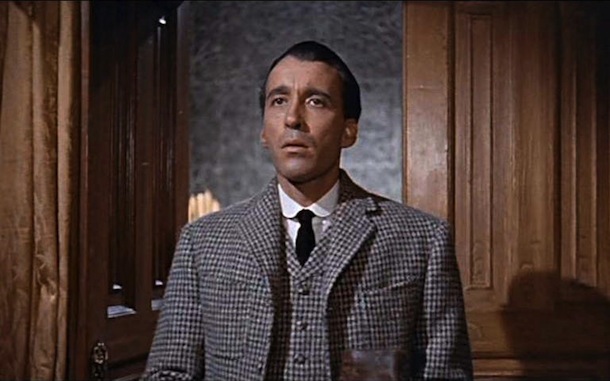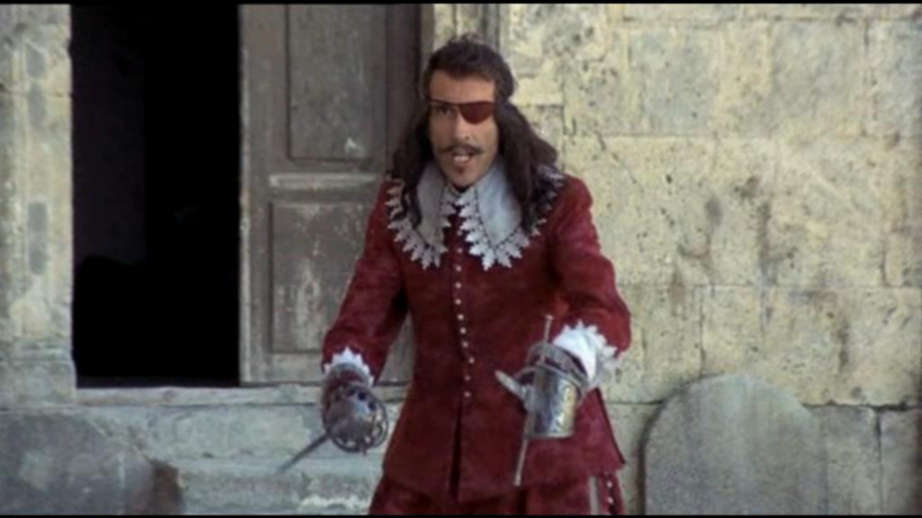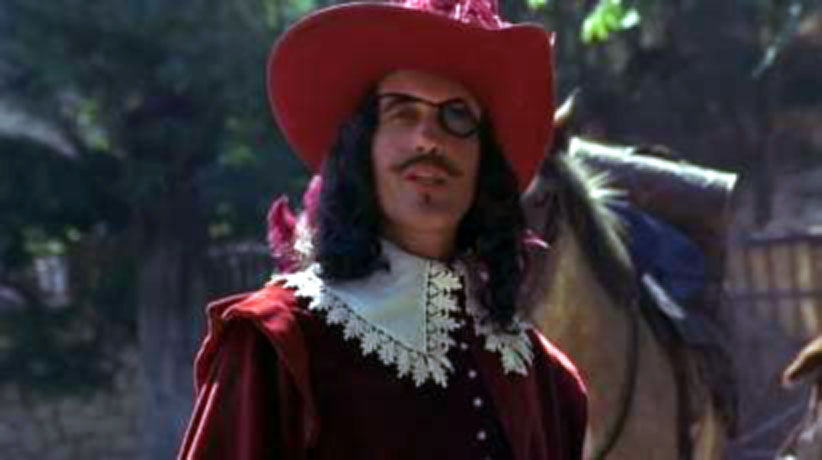
Christopher Lee as Rochefort – the character who influenced my dating decisions for the rest of my life
When I was young (back in the mists of time and the days of yore when adventure was in the offing and there were no cell phones, TV remotes or personal computers), I developed a major crush. Like many other pre-teens at the time, I fell hard for a celebrity. Unlike many other pre-teens at the time, I didn’t fall for a teeny bopper idol like David Cassidy, Shaun Cassidy or Leif Garrett (although I did think Davy Jones from The Monkeys was kinda cute). No, when I fell (and fell hard, with the kind of obsession that only pre-teens and stalkers can summon), it was for an older man. A much older man. A man 40 years older than my 13 year old self, British actor Christopher Lee.
I can’t quite remember when I first saw him. It might have been in one of the wonderful Hammer horror movies where Lee played Dracula (bite me, pleaseohplease, bite me!) or his turn as the fainting Sir Henry in Hound of the Baskervilles. I watched a lot of horror movies from an early age. But the movie and the role that really captured my young imagination (and slowly developing hormones) was The Three Musketeers, directed by Richard Lester, and starring an awesome cast. As fond as I am as Gene Kelly as D’artagnan, there will never be a better four musketeers than Michael York, Oliver Reed, Frank Finley and Richard Chamberlin. but the awesome sauce on top of it all was Christopher Lee as the one-eyed villain Rochefort.
Oh man… he could sword fight. He had this amazing deep and resonant voice. He had an eye patch… and he started my fixation with men in cavalier garb. Christopher Lee is the reason that almost every significant male interest in my life either knew how to sword fight or was willing to learn, and also didn’t mine dressing up in boots, breeches, and full sleeved white shirts.
I wanted to be Milady de Winter ’cause she had a thing going with Rochefort. But I also wanted to learn to sword fight. No damsel in distress role for me. With my friend Cindi, I started writing Three Musketeers fan fiction with myself as Constance DuVallon, sister to Porthos. She of course, was taught to sword fight at a young age because that happened all the time back then, right? Well, in my world it did, and that was all that mattered. I filled a dozen little notebooks with my fantasy life as a 17 century noblewoman who knew how to sword fight and who just happened to be Milady’s half sister or something like that, and who just happened to catch the eye of Rochefort (the eye… get it? Hahahahah!!! okay…).
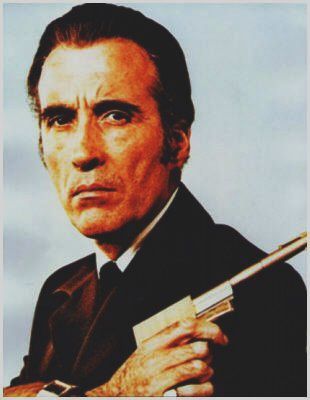
Raowr…
It didn’t stop with Rochefort, though. Once my infatuation well and truly set in, I would watch anything and everything Christopher Lee was in. I’d scan the TV guide every week for his movies and when I found the listings, I’d cut them out and save them in a cigar box where I kept all my special ‘stuff.’ I must have cut out fifty or so over the years. I bought horror movie coffee table books, collecting as many as possible so I would have a diverse selection of Christopher Lee pictures and bios. I’d scan the photos for sale at conventions such as ComicCon for eight by tens of my hero. I wondered why anyone would choose Roger Moore’s bland James Bond over Christopher Lee’s devastatingly sexy Scaramanga “the Man with the Golden Gun.” I also conveniently ignored the existence of his wife, who I’m sure was a wonderful woman and probably a bit more age appropriate. She just wasn’t me.
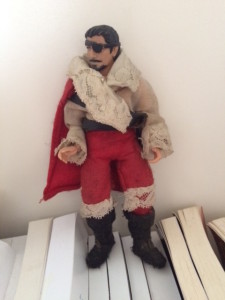
“Where’s my damn hat?”
The best present I remember receiving as a child was one Christmas when I found a Rochefort doll sticking out of the top of my Christmas stocking. My sister Lisa had taken an Ivanhoe action figure and hand made a Rochefort outfit for it, including hat with a stitched black yarn “wig” attacked inside. It’s not included in this picture because one of the cats dragged it off and I hid it away for safe-keeping, evidently in a place so safe that I can’t find it now…
My family was also amused by my infatuation with a man forty years older than my 13 year old self. They teased the hell out of me. But it didn’t matter. I knew it could work. We even collectively wrote a poem about it, which I’ve included below. This year I turned 53; the same age Christopher Lee was when my 13 year old self developed such a crush on him. It seems funny (ironic) to me now that back then I thought 53 was OLD. Like, ‘you’re gonna die in a few years, old man!’ old. Now it seems impossibly young (I’m not middle-aged, NOOOOO!)!!
At any rate… the poem. And forgive me, Christopher Lee, for sending you to hell ’cause I don’t really believe in it anyway and also, you would never go there ’cause you brought so much happiness to so many people. It’s just that it rhymed, y’know?)
Christopher Lee is 53
Christopher Lee is 54.
we don’t have to say 53 any more.
Christopher Lee is 55.
I’m surprised he’s still alive
Christopher Lee is 56.
He’s sick but nothing we can’t fix
Christopher Lee is 57.
Now he’s on his way to heaven.
Christopher Lee is 58.
He’s knocking at the pearly gates.
Christopher Lee is 59.
He’s meeting with the one divine
Christopher Lee is 60… well…
Now he’s on his way to hell.
When I found out Christopher Lee had passed away, I cried, the first time I’d actually shed tears over the death of a celebrity. I realized how much of a benign influence this man had on my life, his charisma and roles helping to shape the paths I took and the interests that became passions, such as sword fighting, the horror genre and… well, men in cavalier garb. He was a vital, talented man until the end and he will always be my very first love, even if he never knew it. 🙂

